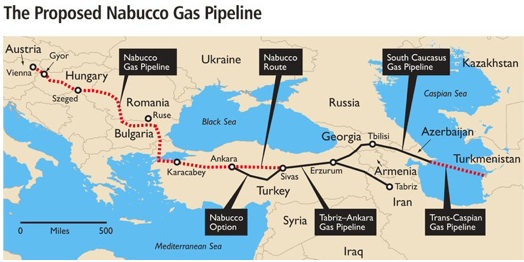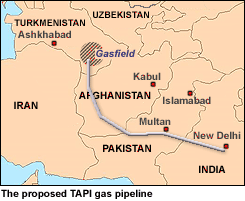How to beat Iran’s pipeline strategy
Sep 23rd, 2009 by MESH
From Gal Luft
While Washington is mulling over what to do next in order to weaken Iran economically, this summer the Islamic Republic has taught us a lesson in strategic maneuvering, taking major steps to bolster its economy and geopolitical posture by positioning itself as an indispensable energy supplier to hundreds of millions of people.
Last May, I described here how after 14 years of negotiations, Iran, which has the world’s second largest natural gas reserves, signed a deal to connect its economy with its eastern neighbor, Pakistan, via a 1,300-mile natural gas pipeline. Both Iran and Pakistan hope to extend the pipeline into India and perhaps even into China. This would not only give Iran a foothold in the Asian gas market and ensure that millions of Pakistanis, Indians and perhaps Chinese are beholden to Iran’s gas, but it would also provide Iran with an economic lifeline and the diplomatic protection energy-dependent economies typically grant their suppliers.
Not wasting any time, Iran is now implementing the second tenet of its pipeline strategy. In July, it announced that by the end of 2009 it will be connected with its northern neighbor, Turkmenistan, Central Asia’s largest gas producer, via a pipeline. Turkmenistan’s interest in pumping its gas to Iran stems from its desire to diversify its export market. Two-thirds of Turkmenistan’s gas flow to Russia, and the dependence on one major client allows Moscow to take advantage of its former republic. But why would energy-rich Iran want to import gas from its neighbor? The answer is the Nabucco pipeline.
For some years, a number of European governments and a consortium of energy companies have been lobbying for the construction of a pipeline from Central Asia via Turkey and the Balkan states to Austria, aimed to ease Europe’s dependence on Russian gas. Last July an intergovernmental accord on Nabucco was signed in Ankara. Scheduled to be completed by 2014 at a cost of over $11 billion, the 2,000-mile pipe is estimated to supply between 5-10 percent of the EU’s projected gas consumption in 2020.

The problem, though, is that it is far from certain where the gas for Nabucco would come from. To date, not a single gas-producing country has signed on to the project. The U.S. position toward Nabucco has been supportive, with the caveat that no Iranian gas should supply the pipeline. But this is an exercise in self-delusion. Even if the 10-15 billion cubic meters of gas per year projected to be tapped from Azeri fields were to become available, much gas would still be needed to meet the pipeline’s capacity of 31 billion cubic meters of gas a year. No doubt about it: Nabucco would have to access both Turkmen and Iranian reserves.
This inconvenient truth is well known to all those involved with the project. But in order to maintain U.S. support, European governments, Turkey—the main transit state—and the consortium of companies which have undertaken to build the pipeline have made sure to drop Iran’s name from any official document or statement related to Nabucco. Tehran, so it seems, does not believe in denial. Its President Mahmoud Ahmadinejad knows well that making Europe beholden to his gas is the best insurance for his regime and that Iran is an appealing alternative to Russia for those for whom Vladimir Putin is a far bigger menace than him. Once Nabucco is constructed, it will be only a matter of short time before Iranian gas will be requested. Hence, the pipeline to Turkmenistan will also make Iran a conduit for Turkmen gas.
In Iran’s effort to bring its gas into the heart of Europe, it has another project: a 1,100-mile pipeline currently being constructed from Iran’s South Pars gas field through Turkey and onward to Greece, Italy and other European countries. This pipeline is expected to deliver 20.4 billion cubic meters per year.
Whether Iran’s natural gas ends up powering turbines in New Delhi, Karachi or Vienna, one thing is certain: Iran will be richer and more geopolitically indispensable. As in the case of U.S. dependence on Saudi Arabia, China’s on Sudan or Germany’s on Russia, energy dependency is a major driver of foreign policy. Once these new gas conduits are established, it will be far more difficult for the United States to gather international support for policies aimed to reign in Iran.
All of these developments have received little attention in Washington, where sanctions on imported gasoline are the only game in town when it comes to crippling the mullah’s regime. Unlike the Bush administration, which was vocally opposed to the Iran-Pakistan-India pipeline, the Obama Administration has been mute on the issue. Instead, it has pressured India to give more consideration to global warming, essentially pushing India to shift from coal-powered electricity to cleaner burning Iranian natural gas. In doing so, the Obama administration has demonstrated that environmental stewardship enjoys higher priority than nuclear proliferation. At a volatile time when the Taliban is at Islamabad’s gate, the Obama administration has also refrained from pressuring Pakistan to reconsider its decision to provide Iran with an umbilical cord. As a result, should the worst happen and a Taliban-style regime take over Pakistan, the economies of the world’s most radical Shiite state and that of what could be the world’s most radical Sunni state would be connected to each other for decades to come like conjoined twins.
 But all’s not lost. The Obama administration should actively promote alternative energy corridors which will prevent Iranian gas from reaching major markets while addressing Asia’s and Europe’s energy needs. One potential gas-pipeline project is the Turkmenistan-Afghanistan-Pakistan-India (TAPI) pipeline. The project can supply Pakistan and India as much gas at a lower construction cost, while providing the impoverished Afghan government with a steady revenue stream in the form of transit fees. Most important, TAPI would allow Turkmenistan to sell its gas to India, enriching two U.S. allies (Afghanistan and Pakistan) rather than selling the same gas to Europe, enriching a U.S. enemy (Iran).
But all’s not lost. The Obama administration should actively promote alternative energy corridors which will prevent Iranian gas from reaching major markets while addressing Asia’s and Europe’s energy needs. One potential gas-pipeline project is the Turkmenistan-Afghanistan-Pakistan-India (TAPI) pipeline. The project can supply Pakistan and India as much gas at a lower construction cost, while providing the impoverished Afghan government with a steady revenue stream in the form of transit fees. Most important, TAPI would allow Turkmenistan to sell its gas to India, enriching two U.S. allies (Afghanistan and Pakistan) rather than selling the same gas to Europe, enriching a U.S. enemy (Iran).
Washington should therefore impress upon Islamabad, recipient of $1 billion-plus yearly of U.S. aid, to adopt TAPI rather than the Iran-Pakistan-India pipeline.
If the United States aims to stop Iran’s ambitions for regional hegemony, it is also in its interest to advance Europe’s and India’s use of renewable electricity and even coal rather than natural gas. And if those two markets insist on using gas, this gas should come in the form of liquefied natural gas (LNG) which can be imported from any gas exporter rather than in the form of Iranian gas.
The United States should cooperate with India on the development of a thorium nuclear fuel cycle rather than the commonly used highly problematic uranium-based nuclear fuel cycle. Thorium cannot be used as bomb material in any way; its fuel cycle is inherently incapable of causing a meltdown; its waste material consists mostly of 233-uranium, which can be recycled as fuel; its waste material is radiotoxic for tens of years, as opposed to the thousands of years with today’s standard radioactive waste; and it exists in greater abundance than uranium.
Only this month India announced that it has designed a new version of its advanced heavy water atomic reactor which will use thorium and low-enriched uranium (instead of highly enriched uranium) as fuel. At a time when the entire Middle East is going nuclear, this is a major opportunity for the United States to cooperate with India—after Australia, India and the United States have the second- and third-largest reserves of thorium—on advancing a safe pathway to globally-used peaceful nuclear power.
Finally, the United States should curb its enthusiasm toward Nabucco, take a more sober look at it and see the project for what it is: an economic lifeline for Iran. While this ambitious pipeline project may serve the interests of some European countries it would inevitably undermine those of the United States. Here the United States will find commonality of interests with Russia, the main opponent of Nabucco.
Nabucco was Verdi’s opera about the difficult plight of Jews under the ancient Persian Gulf ruler, Nebuchadnezzar. What an historical irony it would be if this eponymous pipeline ended up emboldening a modern regional ruler, one with much more sinister plans.
 Posts+Comments
Posts+Comments Posts+Comments
Posts+Comments Posts+Comments
Posts+Comments Posts+Comments
Posts+Comments